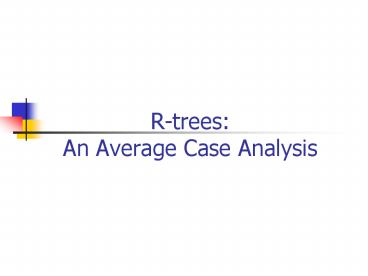R-trees: An Average Case Analysis - PowerPoint PPT Presentation
1 / 23
Title:
R-trees: An Average Case Analysis
Description:
... point dataset, we can use the Fractal Dimension to find the 'average' structure of the tree ... of R-trees Using the Concept of Fractal Dimension'. Proc. ... – PowerPoint PPT presentation
Number of Views:34
Avg rating:3.0/5.0
Title: R-trees: An Average Case Analysis
1
R-trees An Average Case Analysis
2
R-trees - performance analysis
- How many disk (node) accesses well need for
- range
- nn
- spatial joins
- why does it matter?
3
R-trees - performance analysis
- A because we can design split etc algorithms
accordingly also, do query-optimization - motivating question on, e.g., split, should we
try to minimize the area (volume)? the perimeter?
the overlap? or a weighted combination? why?
4
R-trees - performance analysis
- How many disk accesses (expected value) for range
queries? - query distribution wrt location?
- wrt size?
5
R-trees - performance analysis
- How many disk accesses for range queries?
- query distribution wrt location? uniform
(biased) - wrt size? uniform
6
R-trees - performance analysis
- easier case we know the positions of data nodes
and their MBRs, eg
7
R-trees - performance analysis
- How many times will P1 be retrieved (unif.
queries)?
x1
P1
x2
8
R-trees - performance analysis
- How many times will P1 be retrieved (unif. POINT
queries)?
x1
1
P1
x2
0
0
1
9
R-trees - performance analysis
- How many times will P1 be retrieved (unif. POINT
queries)? A x1x2
x1
1
P1
x2
0
0
1
10
R-trees - performance analysis
- How many times will P1 be retrieved (unif.
queries of size q1xq2)?
x1
1
P1
x2
q2
0
q1
0
1
11
R-trees - performance analysis
- Minkowski sum
q2
q1
q1/2
q2/2
12
R-trees - performance analysis
- How many times will P1 be retrieved (unif.
queries of size q1xq2)? A (x1q1)(x2q2)
x1
1
P1
x2
q2
0
q1
0
1
13
R-trees - performance analysis
- Thus, given a tree with n nodes (i1, ... n) we
expect
14
R-trees - performance analysis
- Thus, given a tree with n nodes (i1, ... n) we
expect
volume
surface area
count
15
R-trees - performance analysis
- Observations
- for point queries only volume matters
- for horizontal-line queries (q20) vertical
length matters - for large queries (q1, q2 gtgt 0) the count N
matters - overlap does not seem to matter (but it is
related to area) - formula easily extendible to n dimensions
16
R-trees - performance analysis
- Conclusions
- splits should try to minimize area and perimeter
- ie., we want few, small, square-like parent MBRs
- rule of thumb shoot for queries with q1q2 0.1
(or 0.05 or so).
17
More general Model
- What if we have only the dataset D and the set of
queries S? - We should predict the structures of a good
R-tree for this dataset. Then use the previous
model to estimate the average query performance
for S - For point dataset, we can use the Fractal
Dimension to find the average structure of the
tree - (More in the FK94 paper)
18
Unifrom dataset
- Assume that the dataset (that contains only
rectangles) is uniformly distributed in space. - Density of a set of N MBRs is the average number
of MBRs that contain a given point in space. OR
the total area covered by the MBRs over the area
of the work space. - N boxes with average size s (s1,s2), D(N,s) N
s1 s2 - If s1s2s, then
19
Density of Leaf nodes
- Assume a dataset of N rectangles. If the average
page capacity is f, then we have Nln N/f leaf
nodes. - If D1 is the density of the leaf MBRs, and the
average area of each leaf MBR is s2, then - So, we can estimate s1, from N, f, D1
- We need to estimate D1 from the datasets
density
20
Estimating D1
Consider a leaf node that contains f MBRs. Then
for each side of the leaf node MBR we have
MBRs Also, Nln leaf nodes contain N MBRs,
uniformly distributed. The average distance
between the centers of two consecutive MBRs is
t (assuming 0,12 space)
t
21
Estimating D1
- Combining the previous observations we can
estimate the density at the leaf level, from the
density of the dataset - We can apply the same ideas recursively to the
other levels of the tree.
22
R-treesperformance analysis
- Assuming Uniform distribution
- where
- And D is the density of the dataset, f the fanout
TS96, N the number of objects
23
References
- Christos Faloutsos and Ibrahim Kamel. Beyond
Uniformity and Independence Analysis of R-trees
Using the Concept of Fractal Dimension. Proc.
ACM PODS, 1994. - Yannis Theodoridis and Timos Sellis. A Model for
the Prediction of R-tree Performance. Proc. ACM
PODS, 1996.































